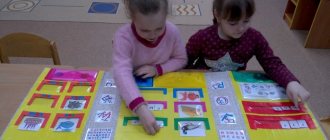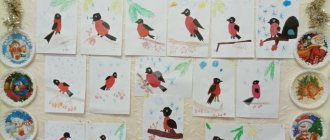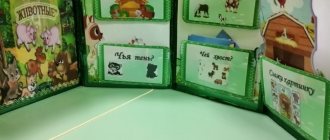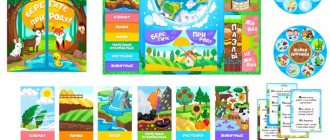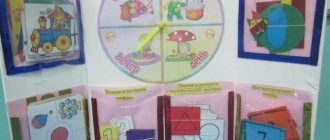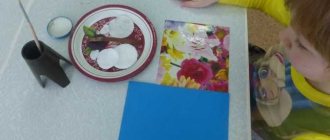Lapbook on the theme “Winter”
- April 4, 2017
International and All-Russian competitions
All-Russian master class “Lapbook as a learning tool in the context of the implementation of the Federal State Educational Standard for Education”
Dear colleagues, the long-awaited spring has arrived. The sun is warming, lifting your mood. The cold, snowy winter is over. And yet, allow me to present to your attention a laptop on the theme “Winter”.
The purpose of creating a lapbook: To consolidate knowledge on the topic “Winter” in 3-4 year old students.
Tasks:
- Update and consolidate children’s knowledge on the topic “Winter”.
- Expand and enrich your vocabulary.
- To develop skills in working with lapbooks in individual, pair and subgroup activities.
Lapbook contents:
- Birds
- Feed the birds
- Sport
- Fun
- Fold a snowflake
- Find the figure
- Poetry
- Coloring pages
- Puzzles
- Tell me about the picture
The laptop is double-sided, that is, pockets with tasks are located on both sides.
Let's look at the first one.
In the center is a winter picture that you can look at and make up stories.
Underneath there is a “ Riddles ” pocket. Here are cards with riddles related to winter: New Year's attributes, sports equipment, weather phenomena. On each card there is a picture of the answer.
There are two pockets on the right half:
“Birds ” - cards with images of wintering birds. Children consolidate knowledge about wintering birds and their appearance.
“ Feed the Birds ” – cards with pictures of different types of bird food. Children consolidate their knowledge of what they can and cannot feed birds.
On the left half there are pockets, united by the theme of physical activity in winter:
“ Sport ” - cards for consolidating knowledge about winter sports, sports equipment, talking about your physical education activities or sports games.
“ Fun” - cards about winter fun; by looking at them, preschoolers can tell stories from personal experience.
Let's move on to the second side:
Here, as on the first side, in the center there is a winter picture for viewing and composing stories.
Underneath is a “ Tell me from the picture ” pocket. There are several pictures in it, the guys can choose any of them. The tasks can be different - answer questions based on a picture, come up with a short story, choose words to describe, etc.
On the right side:
Pocket " Poems ". It contains small cards - pictures with poems on winter themes. For reading to children, for memorizing, for independently telling each other familiar poems.
Second pocket: “ Coloring books ” on winter themes for the development of fine motor skills. Now it is empty, because... The kids love to color.
On the left half:
Task “ Fold a snowflake ”. During the game, tasks are solved: to teach how to put together a whole image from two parts, develops visual perception, fine motor skills and coordination of movements.
In the second pocket is the task “ Find the figure ”. Small cards depict various winter landscapes. Part of the picture - the landscape - is missing. The missing part represents a geometric shape (circle, square, triangle, rectangle). Children find this part, making up the whole image.
Materials used: all illustrations are taken from Yandex. Images.
PASSPORT of the Didactic Manual Lapbook “Zimushka - Winter”
PASSPORT
Didactic manual
Lapbook “Zimushka - winter”
(for speech development in children of senior preschool age,
NGO “Social and communicative development”, “Speech development”)
Author-developer:
Batchaeva Mariam Khasanonva,
Teach a child - Give the world a person V. Hugo
Our modern world is dynamic and fraught with a huge number of dangers. Even adults often encounter them, but what can we say about children. That is why we, adults, are obliged to tell them about the troubles and threats that may affect them. To do this, you can use special games and have conversations with children about different life situations, the occurrence of which can cause harm.
With the onset of winter, potential dangers on the street do not decrease, therefore, the problem of developing safe behavior in preschoolers during the winter season is urgent.
Winter walks bring great joy to children. But the joy can be overshadowed by very common injuries. Rules that will be presented to them in an accessible and attractive form will help protect children from the unpleasant consequences of winter walks.
.
Every kindergarten teacher is now in search of new forms of organizing educational activities. The result of such a search in my case was a thematic folder or laptop “Winter”.
A lapbook is a visual and practical teaching method, the final stage of independent research work that children have done while studying this topic.
The laptop meets the requirements of the Federal State Educational Standard for Educational Education for a subject-development environment:
It is informative, multi-functional, promotes the development of creativity, has didactic properties, is a means of artistic and aesthetic development of the child, and introduces him to the world of art. The structure and content are accessible to preschool children and provide playful, cognitive, research and creative activity for participants in the pedagogical process.
LAPTOP “ZIMUSHKA-WINTER”
The purpose of creating a lapbook:
Systematization and consolidation of children’s knowledge about winter as a season, characteristic changes in nature (living and inanimate nature, among people when this time of year begins.)
Tasks:
- Systematize children's knowledge about the signs of winter and winter fun.
- Clarify what happens in living and inanimate nature with the arrival of winter;
- Expand and consolidate children's knowledge about wild animals and birds in winter, as they prepare for the winter.
- To develop children’s skills in writing descriptive stories based on pictures with a winter theme.
- Introduce and teach children to distinguish the tracks of animals and birds in the snow.
- Develop cognitive activity in children.
- Develop coherent speech in children.
- Develop fine motor skills.
- Promote the development of memory and thinking through games and exercises.
- To develop in children the ability to work in a team and goodwill towards peers.
- To develop the ability to see and feel the beauty of nature, to admire it.
- To instill in children a caring attitude towards living and inanimate nature in winter.
The laptop consists of several spreads:
1 spread contains materials of oral folk art: proverbs, sayings, riddles, poems.
The 2nd spread is dedicated to the animal world.
Spread 3 reflects people's lives
Turn 4 is aimed at developing cognitive activity.
- Make up a story based on the picture
- game “Find the differences”
- Get out of the maze
Signs of winter.
Purpose: To clarify ideas about the signs of winter. Teach preschoolers to establish the relationship between cold weather and the life of plants, animals and people in winter.
Game “Finish the proverb about winter”
Goal: knowledge of proverbs and sayings about winter, development of memory and attention. Progress of the game: The teacher begins a proverb about winter, the children finish.
Poems about winter.
Goal: Formation of ideas about winter, winter children's fun, winter forest through lines of poetry.
Game “How do animals spend the winter?”
Goal: to develop in children a holistic picture of the world around them and the behavior of animals in nature in winter.
Objectives: to generalize and systematize children’s knowledge of animals, about the characteristics of their behavior in winter, to identify characteristic features of the external structure associated with the habitat and methods of obtaining food, to enrich and expand knowledge about the characteristics of winter nature, to cultivate the ability to take care of animals and birds.
Didactic game “Whose traces?”
Goal: To consolidate the knowledge of preschool children about wild animals, to be able to distinguish the tracks of wild animals in the snow, to develop children’s observation, attention, logical thinking, and speech.
“Wintering birds"
Goal: Expand children's understanding of wintering birds. Develop a kind and caring attitude towards birds, a desire to take care of them.
Game “Dress the doll”
Goal: to form an understanding of some general words: clothing, shoes, to form children’s ideas about a person, parts of the body, to teach how to select items of clothing and shoes in accordance with the season and weather.
Game “Name the winter clothes”
Objectives: To expand children's knowledge about clothing. Enrich children's vocabulary on the topic. Teach children to classify clothes according to a given criterion.
“Winter. Winter fun"
Goal: to consolidate and expand children’s knowledge about winter fun, to increase children’s interest in winter games and entertainment. To cultivate a love for our native nature, for the Russian winter.
Didactic game "Find a pair"
Purpose of the game: to develop observation, attention, subtlety of visual perception, to develop the ability to find the same pattern based on several characteristics: color, shape.
Progress of the game: the presenter gives a card to the player with an image of an item of clothing. Then more cards with images of other items of clothing are laid out in front of the child. The child, among the cards lying in front of him, chooses the one that, in his opinion, is a pair for the card in his hands. The game ends when a pair is found. Then the presenter sums up the result together with the player - the selection of the correct paired card.
Didactic game “Winter sports”.
Goal: to expand and systematize children’s knowledge about winter sports and their significance in human life.
Tasks:
1. To develop in children a cognitive interest in sports, the need for physical activity and physical improvement.
2. Form ideas about a person’s physical qualities (strength, agility, endurance.
3. Recognize and name winter sports, select a pair to the picture:
- by the name of the sport;
- by subject.
Game "Find the Differences"
Goal: Continue to develop the ability to compare objects, establish their similarities and differences (how these objects are similar and how they differ, etc.).
Objectives: Continue to develop the ability to consistently consider, as well as introduce to the colors of the spectrum: red, orange, yellow, green, blue, indigo, violet, white, gray, black. Develop attention, memory, thinking.
Make up a story based on the picture.
Goal: Compose a consistent, coherent story using supporting questions as a plan. Activate vocabulary on the topic “Winter.” Develop control and evaluation skills, attention, memory, thinking, auditory perception.
Recommendations for use:
The didactic manual “Winter” is recommended for use by preschool teachers, parents in individual activities with children, preschoolers of older and school-preparatory age in independent play activities, and in games with peers.
Conclusion
In our interactive folder we have placed a lot of information in a very attractive and interesting form.
As a result, children develop universal skills such as:
- ability to plan upcoming activities;
negotiate with peers; distribute responsibilities;
- search for the necessary information, summarize it, systematize it;
- independently provide explanations to questions that arise;
- make your own decisions, based on your ideas and skills, make choices;
- use oral language to express your thoughts, attitudes, desires.
For children, this is a bright, interesting book; they want to look at it and study it. A laptop encourages active verbal and communicative interaction with adults and peers.
For parents, this is a great opportunity to spend useful and exciting time with their child, organize active communication, the opportunity to learn the interests and potential of the child, show creativity, and participate in the life of the kindergarten.
For teachers - an interactive teaching tool that allows you to organize active speech, communicative, and cognitive activities of students, implementing a differentiated approach; a subject for building communication ties with children and parents, an opportunity to reveal your organizational and creative abilities;
A laptop for preschool educational institutions is part of the didactic support for development zones in groups, a means of motivating the professional and creative development of teachers, and a means of increasing the competence of parents and teachers.
Thus, LEPBUK is a universal manual that can be the result of a project-based, joint and independent activity of children, a thematic week provided for by the educational program of a preschool institution.
Can be used in the implementation of any of the educational areas, ensuring their integration.
MAGAZINE Preschooler.RF
Lapbook “Winter” for children ZRRDidactic manual on speech development for children of senior and preparatory speech therapy groups.
Authors-developers:
- teacher: Tarasova Lyubov Viktorovna
- teacher-speech therapist: Trofimova Natalia Nikolaevna
Municipal autonomous preschool educational institution kindergarten No. 116 of the urban district of the city of Ufa of the Republic of Bashkortostan. Ufa 2021
A laptop is a small homemade folder with pockets, windows, tabs and movable parts, in which materials on one topic are placed. Helps the child better understand and remember the material. This is a good way to review the material covered. In it, everyone can choose a more interesting task that they can do. Helps with individual work with children. At any convenient time, the child simply opens the laptop and happily repeats what he has learned, looking at the book.
The methodological development reveals the functionality of using the didactic manual Lepbook “Winter” , when organizing the educational process on speech development, with preschool children in various types of activities in accordance with the Federal State Educational Standard for preschool education. The methodological development presents our own pedagogical practice, which is used in working with children in the senior and preparatory groups.
The presented material may arouse interest and be useful to practicing teachers, educators, speech therapists and other pre-school specialists, as well as parents.
The manual allows you to solve many problems:
- development of an active vocabulary on a lexical topic
- ability to select words objects and objects, words of action, words of signs
- ability to write sentences
- the ability to correctly determine the course of action and compose a story based on a series of paintings
- the ability to coordinate nouns with numerals
- ability to form diminutive forms of nouns
- use of prepositions in speech
The introduction of the Federal State Educational Standard for Educational Education has identified several directions for the implementation of educational educational standards. Important areas are speech development and cognitive development of preschoolers. The standard defines the following tasks when implementing this direction:
- development of curiosity and cognitive motivation
- formation of cognitive actions, formation of consciousness
- development of imagination and creative activity
- the formation of primary ideas about oneself, other people, objects of the surrounding world, their properties and relationships (shape, color, size, material, sound, rhythm, tempo, quantity, number, part and whole, space and time, movement and rest, causes and consequences, etc., about planet Earth as the common home of people, about the peculiarities of its nature, the diversity of countries and peoples of the world.
The purpose of using this manual: speech development, formation of lexical and grammatical categories of the language; generalization and systematization of ideas about winter as a season.
Tasks:
- speech development of coherent speech
- development of lexical and grammatical categories of language
- increasing children's cognitive interest
- promote the development of memory, thinking, attention through games and exercises
- intensify observation activities
- develop fine motor skills
- cultivate an emotional - positive attitude towards the beauty of the surrounding nature
Contents of the didactic manual.
The manual provides for the study of material on lexical topics. The speech therapy group, children need more careful study, reinforcement, and repetition of material. After getting acquainted with a certain topic, they consolidate the material in different types of activities.
The manual is made up of pages and is intended for children of older and preparatory preschool age.
The practical significance lies in the fact that this manual allows you to increase the efficiency of work in the educational process, ensures sustainable interest and stimulates children to form cognitive skills and develop speech.
1. "Signs of Winter".
Goal: to continue to expand children's understanding of winter as a season.
2. "Answer the question".
Goal: to continue to develop children’s passive and active vocabulary on a lexical topic. Learn to listen to a question and answer it.
3. "All year round".
Goal: to consolidate the ability to distinguish and find the main signs of winter.
4. "Count the wintering birds".
Goal: to consolidate the ability to coordinate nouns with numerals. Continue to develop the ability to compare objects, establish their similarities and differences.
5. "Call me kindly".
Goal: to consolidate the ability to form diminutive forms of words.
6. “Arrange the pictures correctly and make sentences based on the diagrams”.
Goal: to consolidate the ability to correctly determine the course of action and compose a story based on a series of paintings;
7. "Tell me where..."
Goal: continue to strengthen the ability to use prepositions in speech.
8. Proverbs and sayings in mnemonic tables.
Goal: To develop attention, memory, thinking, the ability to compare pictures and words, and to activate children’s speech.
9. Coloring pages on a lexical topic. Labyrinth. Cut pictures.
Goal: to train the small muscles of the fingers, the development of visual and spatial concepts. Develop creative imagination and speech.
10. Riddles.
| Next > |
